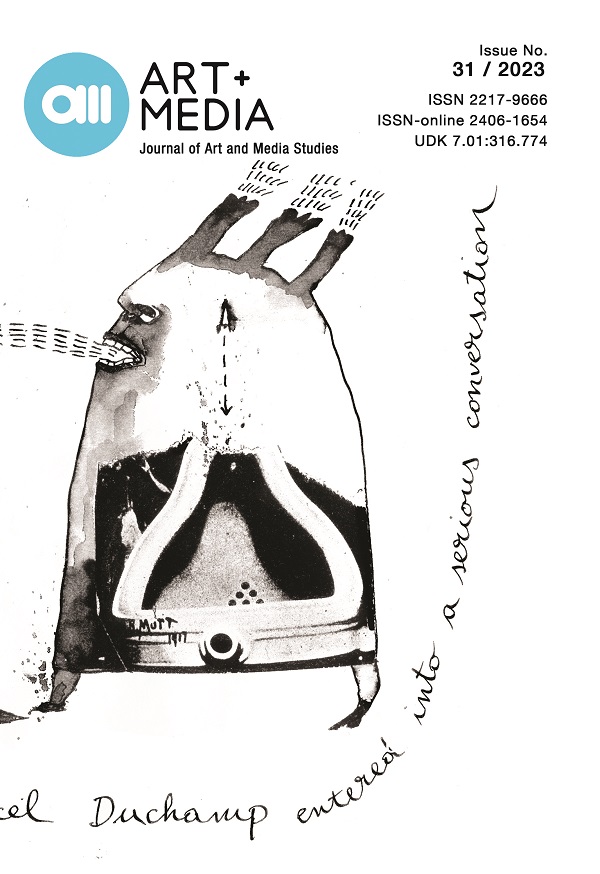Didactic Tool Based on Virtual and Augmented Reality in Art Education: Learning through an Interactive Game
DOI:
https://doi.org/10.25038/am.v0i29.568Keywords:
art teaching; artistic tasks; digital didactic tool; computer game; creativity.Abstract
This article presents research on the results of using a didactic tool based on virtual and augmented reality, developed for solving tasks from the field of spatial design. The theoretical part presents the context of the tool’s development and discusses spatial perception in new media, spatial design of images and screen views, and new media and augmented reality in school practice. The didactic tool consists of a computer, a computer screen, a computer camera, and a set of markers with symbols for different architectural elements that allow different composition operations. Manipulation of the markers is captured by a computer camera, which recognizes the symbols as function keys and allows interaction with a computer program. The computer decodes the data and displays it on the screen as surfaces and solids. This strategy promotes learning like a computer game. We tested it with eighth grade elementary students. The goal was to determine the extent to which the tool would affect the implementation of artistic tasks, creativity, motivation, satisfaction, and understanding of art concepts. The results presented here are encouraging, especially in the area of creativity, which was confirmed by teachers and students after the evaluation.
References
Azuma, Ronald T. “A Survey of Augmented Reality.” Presence: Teleoperators and Virtual Environments 6 (1997): 355–385. https://doi.org/10.1162/pres.1997.6.4.355 DOI: https://doi.org/10.1162/pres.1997.6.4.355
Chandrasekera, Tilanka and So-Yeon Yoon. “Augmented Reality, Virtual Reality and their Effect on Learning Style in the Creative Design Process.” Design and Technology Education: An International Journal 23, 1 (2018): 55–75.
Crary, Jonathan. Suspensions of Perception. London: The MIT Press, 1999. DOI: https://doi.org/10.7551/mitpress/6569.001.0001
Friedberg, Anne. The Virtual Window: From Alberti to Microsoft. London: The MIT Press, 2006.
Debevec, Luka. “Application as a tool for research on the use of new media in teaching spatial design in primary schools.” Ph.D. diss. University of Ljubljana, Faculty of Computer and Information Sciences, 2014.
Grau, Oliver. From Illusion to Immersion. London: The MIT Press, 2003.
Heim, Michael. Virtual Realism. New York: Oxford University Press, 1998. DOI: https://doi.org/10.1093/oso/9780195104264.003.0007
Heydon, Jeff. “The View from the Window.” Canadian Journal of Communication 38, 4 (2013): 531–544. https://doi.org/10.22230/cjc.2013v38n4a2676 DOI: https://doi.org/10.22230/cjc.2013v38n4a2676
Hsiao, Kuei-Fang and Nian-Shing Chen. “The Development of the AR-Fitness System in Education.” In Edutainment Technologies. Educational Games and Virtual Reality/Augmented Reality Applications. Proceedings of the Sixth International Conference on E-learning and Games, September 7–9, 2011, Taipei, Taiwan, edited by W. Y. Chang, M. P. Hwang, W. Mueller, 2–11. Berlin: Springer, 2011.
Kerawalla, Lucinda, Rosemary Luckin, Simon Seljeflot, and Adrian Woolard. “‘Making it real’: exploring the potential of augmented reality for teaching primary school science.” Virtual Reality 10 (2006): 163–174. DOI: https://doi.org/10.1007/s10055-006-0036-4
Kesim, Mehmet and Yasin Ozarslan. “Augmented Reality in Education: Current Technologies and the Potential for Education.” Procedia – Social and Behavioral Sciences 47 (2012): 297–302. https://doi.org/10.1016/j.sbspro.2012.06.654 DOI: https://doi.org/10.1016/j.sbspro.2012.06.654
Manovich, Lev. The Language of New Media. London: Routledge, 2001. DOI: https://doi.org/10.22230/cjc.2002v27n1a1280
Manovich, Lev. “New Media from Borges to HTML.” In The New Media Reader, edited by Noah Wardrip-Fruin and Nick Montfort, 13–25. Cambridge, Massachusetts: The MIT Press, 2003.
Moreno-Ger, Pablo, Daniel Burgos, José Luis Sierra, and Baltasar Fernández-Manjón. “A game-based adaptive learning unit with IMS Learning Design.” In Lecture Notes in Computer Science: Creating New Learning Experiences on a Global Scale, edited by Erik Duval, Ralf Klamm, Martin Wolpers, 247–261. Berlin: Springer, 2007. DOI: https://doi.org/10.1007/978-3-540-75195-3_18
O’Brien, Heather L. and Elaine G. Toms. “Engagement as a process in computer-mediated environments.” In Proceedings of the American Society for Information Science and Technology 42, 1 (2005). https://doi.org/10.1002/meet.14504201233 DOI: https://doi.org/10.1002/meet.14504201233
Pallasmaa, Juhani. The Eyes of the Skin: Architecture, and the Senses. Chichester: John Wiley & Sons Ltd., 2005.
Radu, Iulian. Augmented reality in education: A meta-review and cross-media analysis. Personal and Ubiquitous Computing 18 (2014): 1533–1543. DOI: https://doi.org/10.1007/s00779-013-0747-y
Rountree, Janet, William Wong, and Robert Hannah. “Learning to look: Real and virtual artifacts.” Educational Technology & Society 5, 1 (January 2002, Integrating Technology into Learning and Working, Part 1): 129–134.
Saltan, Fatih, and Ömer Arslan. “The use of augmented reality in formal education: A scoping review.” Eurasia Journal of Mathematics, Science & Technology Education 13, 2 (2017): 503–520. https://doi.org/10.12973/eurasia.2017.00628a. DOI: https://doi.org/10.12973/eurasia.2017.00628a
Shanshan, Li. “Assessing the user experience when using mobile augmented reality in advertising.” Ph.D. diss. Purdue University, 2014. https://docs.lib.purdue.edu/cgi/viewcontent.cgi?referer=&httpsredir=1&article=1232&context=open_access_theses. Accessed on June 21, 2022.
Stokes, Suzanne. “Visual literacy in teaching and learning: A Literature Perspective.” Electronic Journal for the Integration of Technology in Education 1, 1 (2002): 10–19.
Tacol, Tonka. Didaktični pristop k načrtovanju likovnih nalog. Izbrana poglavja iz likovne didaktike [Didactic approach to planning art assignments. Selected chapters from art didactics]. Ljubljana: Debora, 1999.
Vidler, Anthony. Warped Space: Art, Architecture, and Anxiety in Modern Culture. Cambridge MA: The MIT Press, 2001.
Zheng, Shen. “Research on Mobile Learning Based on Augmented Reality.” Open Journal of Social Sciences 3, 12 (2015): 179–182, 2015. https://doi.org/10.4236/jss.2015.312019 DOI: https://doi.org/10.4236/jss.2015.312019
Downloads
Published
How to Cite
Issue
Section
License
Copyright (c) 2023 AM Journal of Art and Media Studies

This work is licensed under a Creative Commons Attribution 4.0 International License.
The content on this site is licensed under a Creative Commons Attribution 4.0 International License.
AM Journal of Art and Media Studies ISSN 2217-9666 - printed, ISSN 2406-1654 - online, UDK 7.01:316.774
Contact: amjournal@outlook.com
Publisher: Faculty of Media and Communications, Singidunum University, Belgrade, Serbia
Indexed in: ERIH PLUS, EBSCO, DOAJ, and in The List of Scientific Journals Categorization of Ministry of Education, Science and Technological Development of Republic of Serbia (M24 in 2021; M23 in 2023). Beginning with No. 12 2017, AM is indexed, abstracted and covered in Clarivate Analytics service ESCI.

